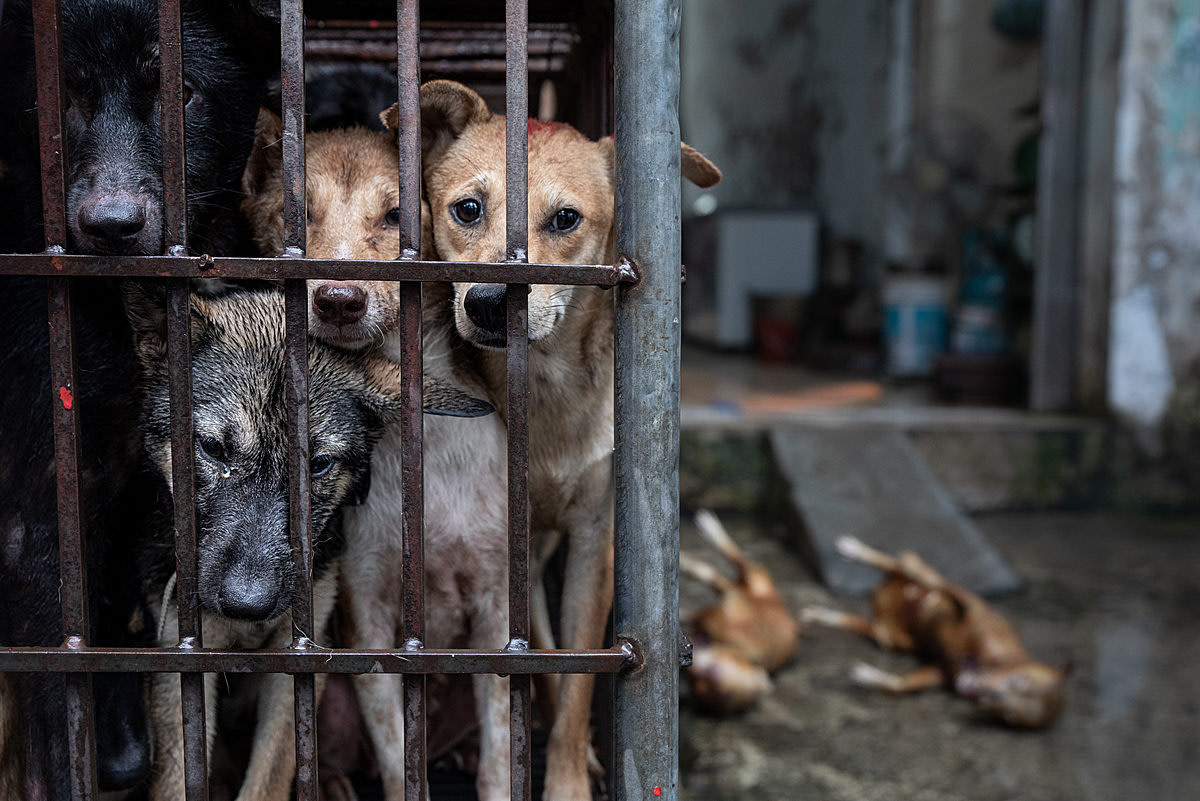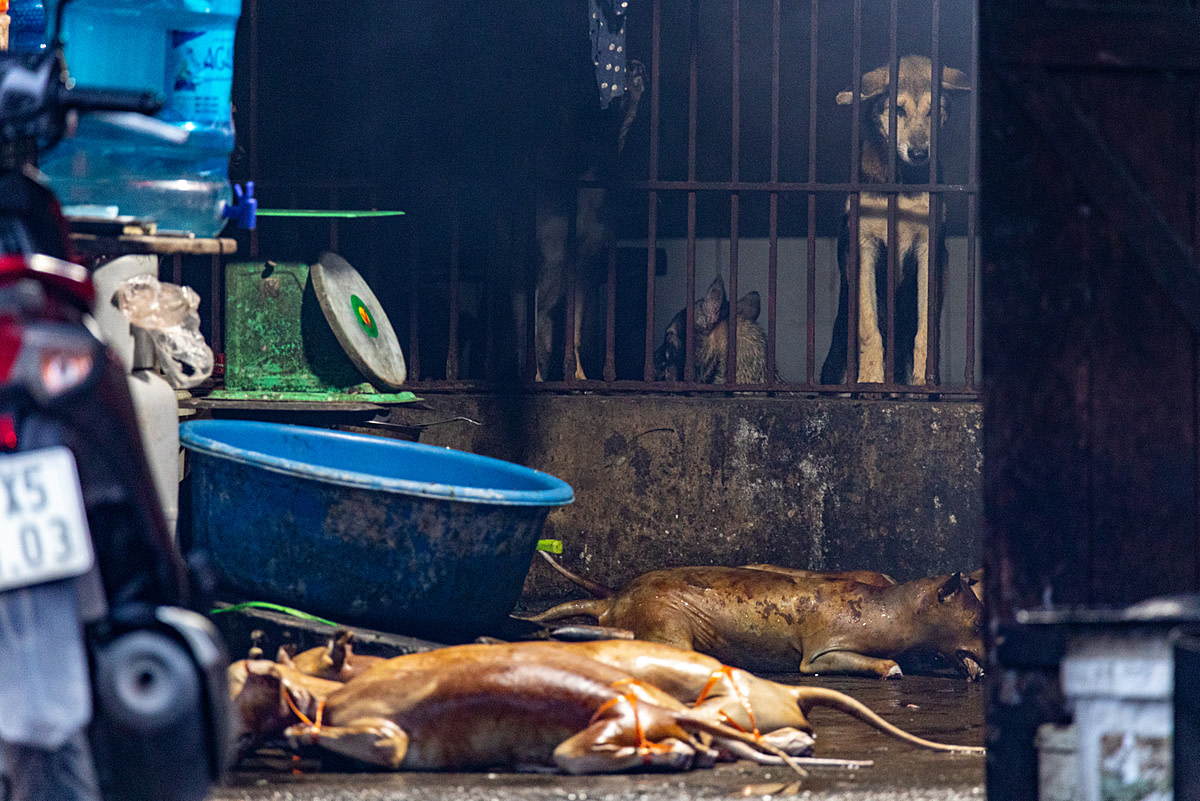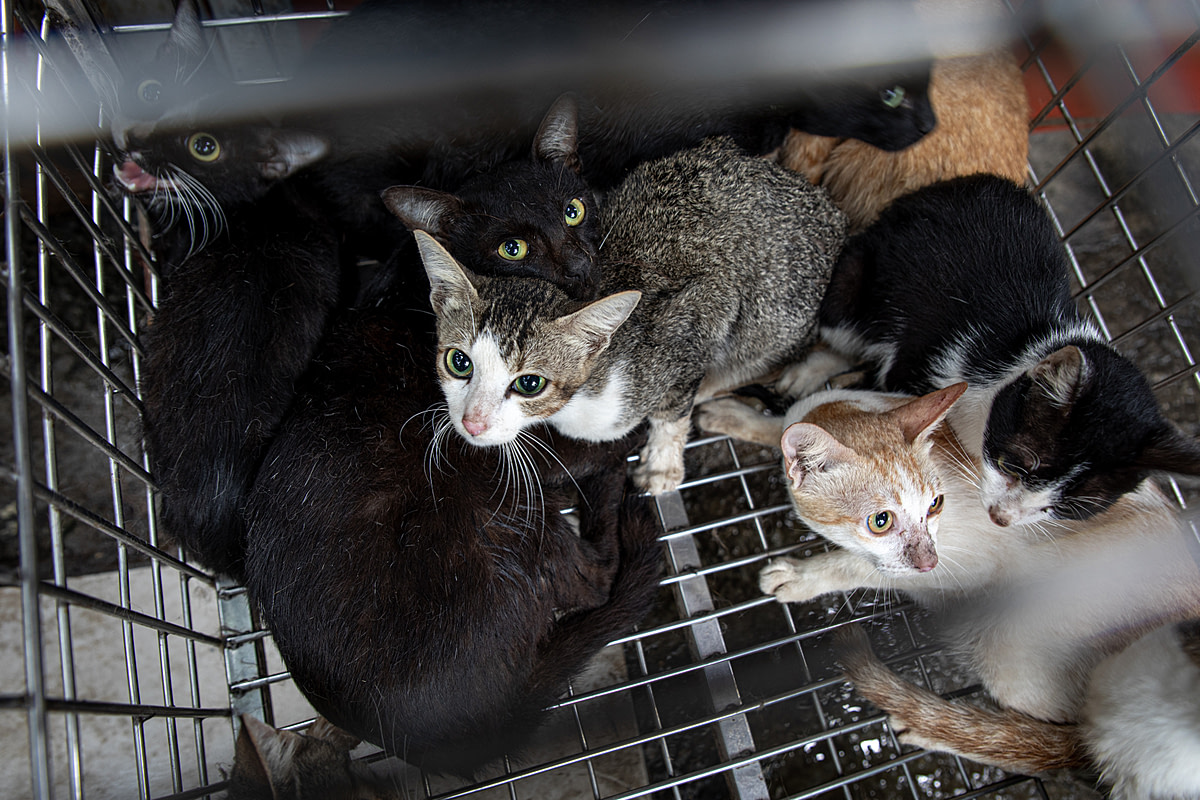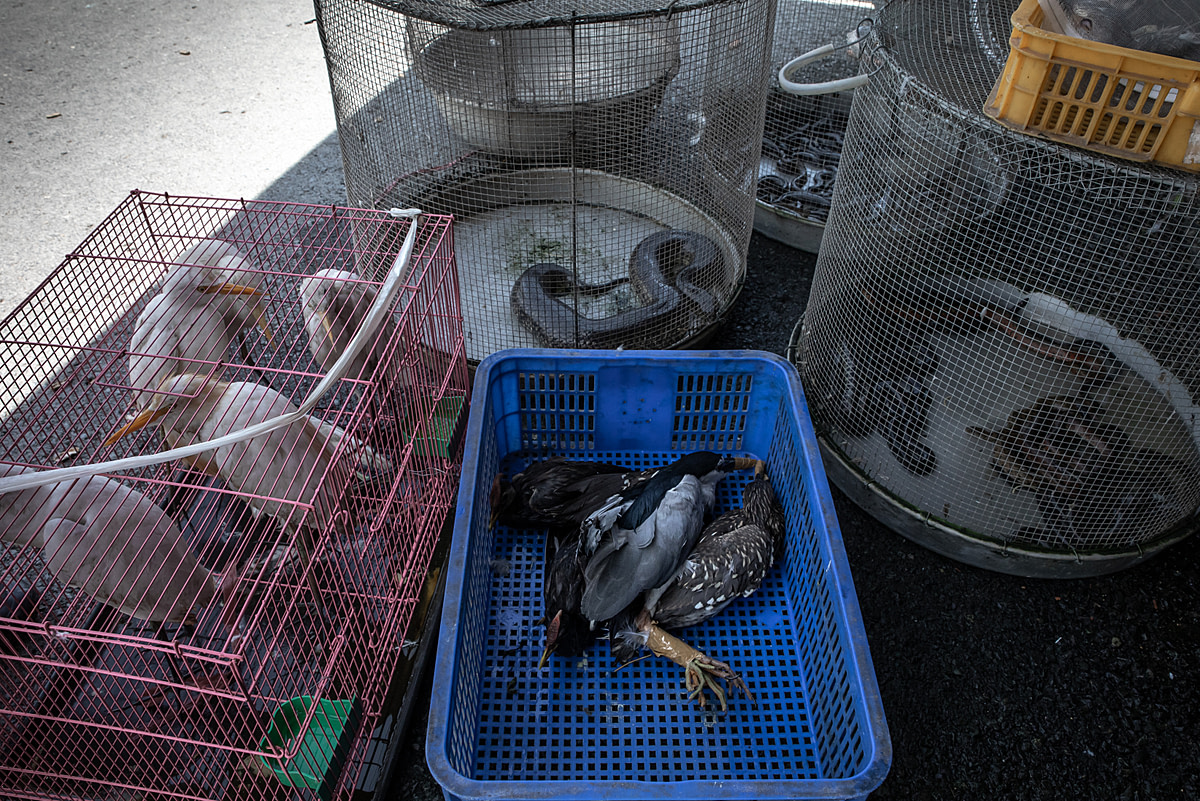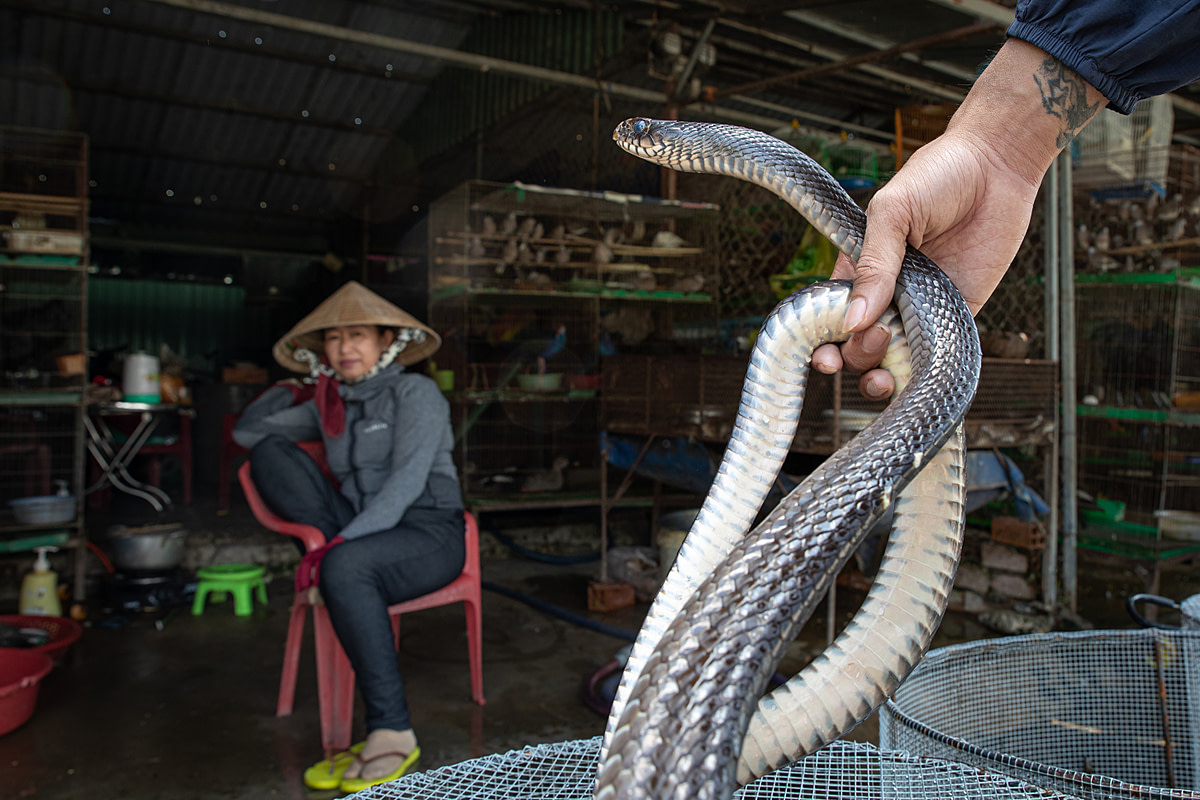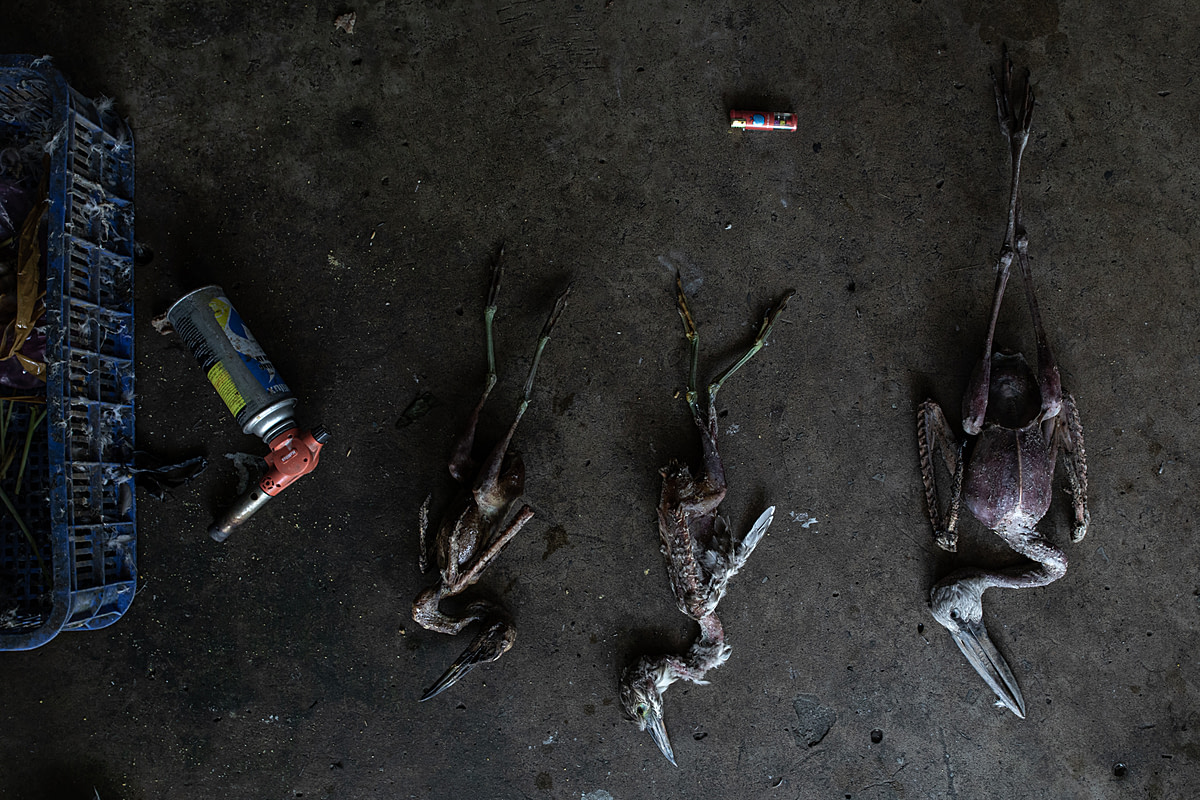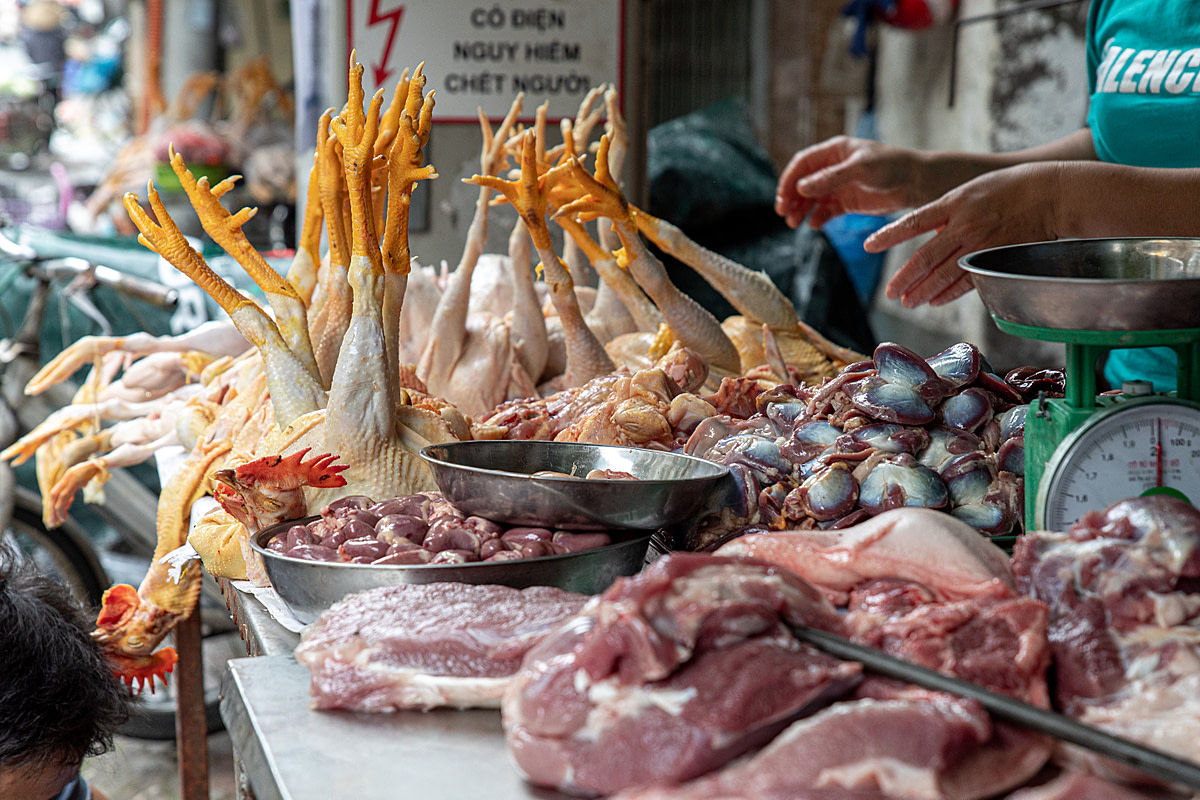Dogs slated to be killed for their meat stare into the camera from within a small and crowded cage at a slaughterhouse on Huu Hung Street in Hanoi. Vietnam, 2022.
Aaron Gekoski / Asia for Animals Coalition / We Animals
[Content warning: Contains confronting images and/or video footage]
A joint investigation by Asia for Animals Coalition and We Animals has revealed brutal and illegal wet market conditions for animals in Vietnam, including dogs and cats, critically endangered wildlife, rats, birds, snakes and toads.
“From poor wildlife tourism venues and the bear bile industry, to the illegal wildlife and dog meat trades, Vietnam faces a host of animal welfare problems. Our investigation of these industries reveals the suffering of countless animals. These markets are also hotbeds for disease which need to be investigated by the authorities.” ― Aaron Gekoski, animal photojournalist
Vietnam's Dog and Cat Meat Trade
National and international media have extensively reported about dog meat consumption, and in 2018, the Vietnamese government declared that it would ban dog meat consumption by 2021. Despite this, the dog killing process can still be seen in public spaces and with the right access also behind closed doors. Đức Thượng Commune in the city of Hanoi, Vietnam’s capital, is one of these spaces.
A caged dog stares down at the hairless, gutted and cleaned bodies of slaughtered dogs lying on wet pavement at a slaughterhouse in the Hoai Duc district of Hanoi, Vietnam. Live dogs are held here with a full view of the cleaning process. Vietnam, 2022.
Aaron Gekoski / Asia for Animals Coalition / We Animals
Vendors typically kill the dogs by striking their heads with plywood, then stabbing them in their hearts. After that, they will put their bodies into a fur-removing machine before burning their skins. Many of these dogs are imported from Cambodia, Laos and Thailand.
The stiffened bodies of several dead dogs are scorched with the flame from a gas torch at a slaughterhouse on Hữu Hưng Street in Hanoi, Vietnam. A worker burns the hair off each dog’s body to make the cleaning process easier before the dog’s body is sold as meat for human consumption. Vietnam, 2022.
Napat Wesshasartar / Asia for Animals Coalition / We Animals
“I normally set aside my emotions and focus on the assignment, however, when I have to go through all of the footage that I shot, it’s heartbreaking. Seeing our companion animals being killed, hearing the sound of the injured dogs, and smelling their blood – it’s horrible and unacceptable. Historically, dog and cat consumption is normal, especially during famine or world war. But Vietnam has been far from that era for years.” ― Napat Wesshasartar, animal photojournalist
While dog meat trade is not illegal, consuming cats was banned in Vietnam in 1998, but this directive was later cancelled in 2020. Vendors openly sell dead cats alongside cages of live cats, destined to be killed and sold as “tiểu hổ” or cat meat.
A live cat howls and stares in distress from within a cage at a slaughterhouse in Hanoi, Vietnam. Many cats are held here in such cages, and each cat is destined to be killed and sold as “tiểu hổ” or cat meat. Vietnam, 2022.
Napat Wesshasartar / Asia for Animals Coalition / We Animals
The consumption of dog meat is more popular in the northern parts of Vietnam than the south. Even now, it is considered a delicacy by some and yet still a staple by others. Despite this, many Vietnamese are fighting to end the practice.
Most of the killing process is conducted in clear view of other living dogs, who are crammed together in groups of about 10 in cages no larger than two square metres. Ten to twenty dogs and cats are usually killed and sold per day at a given market.
“Studies suggest that consuming dogs and cats can cause the risk of infection from deadly parasites such as E. coli and salmonella (commonly found in contaminated meats), as well as the risk of contracting other serious and potentially deadly bacterial diseases.” ― Napat Wesshasartar
A dog pushes their snout through the bars of a cage while another peers into the camera at a slaughterhouse on Huu Hung Street in Hanoi, Vietnam. Destined to be killed for their meat, these caged dogs have a full view of the other individuals slaughtered before them. These dogs will suffer the same fate as the dead dog behind them, whose body lies on the ground as a worker extracts their internal organs. Vietnam, 2022.
Aaron Gekoski / Asia for Animals Coalition / We Animals
Cooked whole dogs and sausage made from dog meat are displayed for sale outdoors at a store on Gam Cau Street in Hanoi.The skin of the cooked dogs has been seared by fire to remove the dog’s hair and preserve the carcasses before they are sold as meat. In the background, a man hands the dog meat vendor payment for a purchase they’ve just made. Vietnam, 2022.
Aaron Gekoski / Asia for Animals Coalition / We Animals
A live dog sniffs at the scorched body of a dead dog that has been placed on top of their cage at a slaughterhouse on Hữu Hưng Street in Hanoi, Vietnam. Many live dogs are crowded into this same cage, all destined to be killed for their meat. Audible in the background are the howls of cats, who are also being held in cages and will suffer the same fate. Vietnam, 2022.
Napat Wesshasartar / Asia for Animals Coalition / We Animals
Read more about Vietnam’s dog and cat meat trade and the efforts of organizations to date to ban it in this report from the Asia for Animals Coalition.
Editor's Note:
Our work in this region was only possible because of Asian advocates who work on behalf of animals across Asia. While these visuals depict a specific region, animal exploitation is a global issue taking place in every country.
Vietnam's Wet Markets and Illegal Wildlife Trade
At another wet market, our photojournalists documented the live animals that vendors commonly sell for human consumption: pigeons, geese, ducks and chickens. These animals are kept in tightly packed cages. Pigeons have their heads chopped off while they are still alive before they are boiled to more easily remove feathers. Toads are tied with red plastic string to prevent them from moving.
Storks, ducks, and snakes, both alive and dead, are displayed at the Thanh Hoa Bird Market, which is an exotic animal market in Vietnam. This market has many species of animals for sale. Vietnam, 2022.
Aaron Gekoski / Asia for Animals Coalition / We Animals
Groups of bullfrogs are tightly tied together with red ribbon to prevent movement at a wet market. Vietnam, 2022.
Napat Wesshasartar / Asia for Animals Coalition / We Animals
Thanh Hoa Bird Market in Southern Long An province is one of Vietnam’s largest wild bird markets, reported sometimes as “birds’ hell” because birds, snakes, eagles and wildlife are kept in captivity and slaughtered. The scale of the wildlife trade is so large that Vietnam’s forests are emptying from an “animal genocide.”
Some of these animals are critically endangered and protected by law in Vietnam. Most of the animals, including endangered species, are caught in the wild. Some of the shop owners showed elongated tortoises (Indotestudo elongata), a critically endangered species according to the IUCN Red List. Although this market sells birds illegally, and despite statements from authorities that they will stop the slaughter of these birds, our investigators witnessed no evidence of the Vietnamese government taking any such action against the market. On the contrary, vendors sold these animals openly in public spaces.
A rat is dipped into boiling water in order to remove their fur at the Thanh Hoa Bird Market, which is an exotic animal market in Vietnam. They will be cut up and cooked for a customer at the market. Vietnam, 2022.
Aaron Gekoski / Asia for Animals Coalition / We Animals
Again these animals face gruesome conditions and slaughter. When consumers buy animals, vendors often slaughter birds on demand by smashing their heads on a hard surface, such as a counter or floor. Afterwards they boil the animals and remove the feathers or fur, finally burning the skin for food preservation. Other animals are similarly killed: we documented vendors smashing rats onto pavement to kill them and cutting up their bodies with scissors. Our investigators went to great lengths to document these markets, at one point hospitalized from a murder hornet attack after crossing a swamp to reach these cages.
“On walking to the cages, via a swamp, our fixer turned around and ran towards us, screaming and pulling at his hair. He was pursued by a swarm of murder hornets – a notoriously aggressive animal with one of the most painful stings known to humans. Napat and I turned and ran, as the hornets swooped on us, stinging us on our heads, backs, arms and legs. The pain was unreal – like having boiling water poured all over your body. The whole experience had shaken us up, but the pain we experienced was negligible compared to what Vietnam’s animals go through.” ― Aaron Gekoski
Male and female greater painted-snipe shorebirds are tied down a heap atop of a cage at the Thanh Hoa Bird Market, which is an exotic animal market in Vietnam. There is not food or water provided for the birds. Vietnam, 2022.
Napat Wesshasartar / Asia for Animals Coalition / We Animals
In 2021, during the COVID-19 pandemic, the United Nations called for countries to suspend the sale of live wild animals at wet markets because of their risk of spreading emerging deadly diseases; and just recently, Canada announced a ban on the import of dogs from more than 100 countries “to reduce the risk of introducing dog rabies into Canada,” which includes Vietnam. This new measure will prohibit the entry of “commercial dogs” as of September 28, 2022, and could impact dogs rescued from the meat trade who are currently sent over to countries such as Canada for adoption.
A dog looks anxiously into the camera as they try to rest while pressed up against the bars of a cage crowded with live dogs at a slaughterhouse on Hữu Hưng Street in Hanoi. These dogs will be killed and butchered for their meat which will be sold for human consumption. Audible in the background are the howls of a distressed dog. Vietnam, 2022.
Napat Wesshasartar / Asia for Animals Coalition / We Animals
“I’ve seen dogs clubbed over the head and stabbed in the throat, rats smashed against the pavement and then cut up with scissors, turtles pulled apart alive, and some of the most inhumane treatment of animals imaginable… No matter how you try and rationalise it, the pain we inflict upon other living beings cannot be justified. No food or medicine is worth the immense suffering that precedes it.” ― Aaron Gekoski
These visuals provide a raw glimpse into Vietnam’s dog meat trade and wet markets, and expose intense animal suffering and illegal sales.
Data Sources: Asia for Animals Coalition / Four Paws / The New York Times / United Nations / Government of Canada
Explore and download more visuals from this collection via our stock platform.

